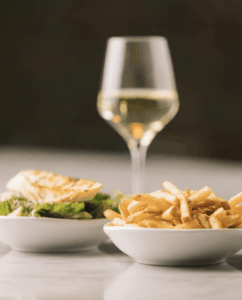Girl Dinner: When a Snack Becomes a Strategy
Published on October 29, 2025, at 1:54 p.m.
by Parker Schell
What started as a silly trend on TikTok is now a marketing movement. “Girl dinner” is shaping how restaurants across America are attracting women.

The girl dinner trend started with young women posting videos of small snack plates for a meal rather than a full plate with a traditional entree and sides. The original video was posted by Olivia Maher, featuring a “medieval” array of grapes, bread and cheese. The video compared few-ingredient, snack-ish spreads from the medieval times to Maher’s.
Between TikTok and Instagram, #girldinner currently has over 400,000 posts. While this is advertised towards women, these low-effort meals are something almost everyone has surely had for dinner on a night at home alone.
This trend took over all of our feeds last year, with many young women relating to the appeal of random snacks paired together. According to The Washington Post, TikTok has anointed a Caesar salad, fries and a martini as the “it girl” meal. This salty combo, while extremely simple, is capturing a lot of attention.
Sugo, an Italian restaurant located in Tuscaloosa, Ala., recently added girl dinner to its menu, and from the hours of 6 to 9 on weeknights, college girls are filling almost every seat. Sugo’s girl dinner includes a serving of pasta, french fries and caesar salad along with a glass of wine or a cocktail, all for just $20. While some are rolling their eyes at this lack of protein, an entire audience is making plans for girls’ night.

This trend is giving PR professionals in the restaurant industry an opportunity to market such a simple meal as a whole new experience. However, this doesn’t come without risks. Because girl dinner isn’t exactly promoting nutritional balance, restaurants have to be careful that these new menu items aren’t promoting restriction.
“Please Don’t Gender My Dinner,” an article in Food & Wine, heavily criticizes girl dinner. “Like many other social media trends, girl dinner creates a spectacle out of women eating.” So where is the line? Is it more important to be trendy or to advertise healthier alternatives and avoid gender norms as a whole?
This isn’t the first time that PR professionals have had to decide how far we are willing to go with the media’s concept of gender roles, and it certainly won’t be the last. While girl dinner might seem like a fun, light-hearted take on snacking, it can also imply to some that women don’t—or shouldn’t—eat a full-course meal.
Girl dinner is what you make it. I don’t buy the idea that this trend is encouraging women to eat small, unbalanced meals. Sometimes random things, all thrown together, is the perfect dinner. It’s less about restriction and more about embracing the beauty of low-effort meals. Let’s admit it. We all love a glorified snack plate.




